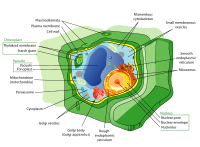
Time‐resolved interaction proteomics of the GIGANTEA protein under diurnal cycles in Arabidopsis
Sign Up to like & getrecommendations! Published in 2019 at "Febs Letters"
DOI: 10.1002/1873-3468.13311
Abstract: The plant‐specific protein GIGANTEA (GI) controls many developmental and physiological processes, mediating rhythmic post‐translational regulation. GI physically binds several proteins implicated in the circadian clock, photoperiodic flowering, and abiotic stress responses. To understand GI's multifaceted… read more here.
Keywords: interaction proteomics; time; resolved interaction; time resolved ... See more keywords

Wheat (Triticum aestivum. L) Plant U‐box E3 ligases TaPUB2 and TaPUB3 enhance ABA response and salt stress resistance in Arabidopsis
Sign Up to like & getrecommendations! Published in 2022 at "FEBS Letters"
DOI: 10.1002/1873-3468.14536
Abstract: Plant U‐box E3 ligases (PUBs) are important regulators of responses to various abiotic stress conditions. In this study, we found that wheat (Triticum aestivum. L) PUBs TaPUB2 and TaPUB3 enhanced abscisic acid (ABA) responses and salt… read more here.
Keywords: stress; tapub2 tapub3; plant box; arabidopsis ... See more keywords

RNA 5‐Methylcytosine Modification Regulates Vegetative Development Associated with H3K27 Trimethylation in Arabidopsis
Sign Up to like & getrecommendations! Published in 2022 at "Advanced Science"
DOI: 10.1002/advs.202204885
Abstract: Methylating RNA post‐transcriptionally is emerging as a significant mechanism of gene regulation in eukaryotes. The crosstalk between RNA methylation and histone modification is critical for chromatin state and gene expression in mammals. However, it is… read more here.
Keywords: modification; trimethylation; rna; m5c ... See more keywords

Gibberellins are involved in effect of near-null magnetic field on Arabidopsis flowering.
Sign Up to like & getrecommendations! Published in 2017 at "Bioelectromagnetics"
DOI: 10.1002/bem.22004
Abstract: We previously found that flowering of Arabidopsis was suppressed by near-null magnetic field, which was related to the modification of cryptochrome. To disclose the physiological mechanism of this effect, we detected gibberellin (GA) levels and… read more here.
Keywords: field; near null; null magnetic; magnetic field ... See more keywords

RNA structure, binding, and coordination in Arabidopsis
Sign Up to like & getrecommendations! Published in 2017 at "Wiley Interdisciplinary Reviews: RNA"
DOI: 10.1002/wrna.1426
Abstract: From the moment of transcription, up through degradation, each RNA transcript is bound by an ever‐changing cohort of RNA binding proteins. The binding of these proteins is regulated by both the primary RNA sequence, as… read more here.
Keywords: rna secondary; rna; secondary structure; rna structure ... See more keywords

Singlet Oxygen and Protochlorophyllide Detection in Arabidopsis thaliana.
Sign Up to like & getrecommendations! Published in 2021 at "Methods in molecular biology"
DOI: 10.1007/978-1-0716-0896-8_5
Abstract: Since the recognition of the reactive oxygen species singlet oxygen (1O2) as a versatile signal that induces various stress responses, the mechanisms underlying 1O2-induced signaling transduction pathways have become the subject of much current research.… read more here.
Keywords: oxygen; detection; singlet oxygen; arabidopsis ... See more keywords

Measuring Hypocotyl Length in Arabidopsis.
Sign Up to like & getrecommendations! Published in 2022 at "Methods in molecular biology"
DOI: 10.1007/978-1-0716-1912-4_9
Abstract: Circadian clocks allow organisms to synchronize growth to occur at the most optimal time of the day. In plants, the circadian clock controls the timing of hypocotyl (seedling stem) elongation. The activity of the circadian… read more here.
Keywords: hypocotyl elongation; hypocotyl length; elongation; circadian clock ... See more keywords

Generation of a Stress-Inducible Luminescent Arabidopsis and Its Use in Genetic Screening for Stress-Responsive Gene Deregulation Mutants.
Sign Up to like & getrecommendations! Published in 2017 at "Methods in molecular biology"
DOI: 10.1007/978-1-4939-7136-7_6
Abstract: In order to understand plant stress tolerance and its application, it is important to identify the signaling components involved in the stress-regulated gene expression. One initial step for this is generation of a stress-inducible luminescent… read more here.
Keywords: generation; stress; stress inducible; arabidopsis ... See more keywords

Ectopic Vascular Induction in Arabidopsis Cotyledons for Sequential Analysis of Phloem Differentiation.
Sign Up to like & getrecommendations! Published in 2018 at "Methods in molecular biology"
DOI: 10.1007/978-1-4939-8657-6_10
Abstract: Vascular system is vital for the transport of water and nutrients as well as for providing mechanical support in many land plants. Plant transcription factors play a central role in regulating vascular development downstream of… read more here.
Keywords: phloem differentiation; analysis; differentiation; induction ... See more keywords

Expression profiling of AUXIN RESPONSE FACTOR genes during somatic embryogenesis induction in Arabidopsis
Sign Up to like & getrecommendations! Published in 2017 at "Plant Cell Reports"
DOI: 10.1007/s00299-017-2114-3
Abstract: Key messageExtensive modulation of numerous ARF transcripts in the embryogenic culture of Arabidopsis indicates a substantial role of auxin signaling in the mechanism of somatic embryogenesis induction.AbstractSomatic embryogenesis (SE) is induced by auxin in plants… read more here.
Keywords: response; somatic embryogenesis; expression; induction ... See more keywords

DELLA proteins negatively regulate dark-induced senescence and chlorophyll degradation in Arabidopsis through interaction with the transcription factor WRKY6
Sign Up to like & getrecommendations! Published in 2018 at "Plant Cell Reports"
DOI: 10.1007/s00299-018-2282-9
Abstract: Key messageDELLA proteins’ negative regulation of dark-induced senescence and chlorophyll degradation in Arabidopsis is through interaction with WRKY6 and thus repression of its transcriptional activities on senescence-related genes.AbstractSenescence is an intricate and highly orchestrated process… read more here.
Keywords: senescence; dark induced; dark; chlorophyll ... See more keywords